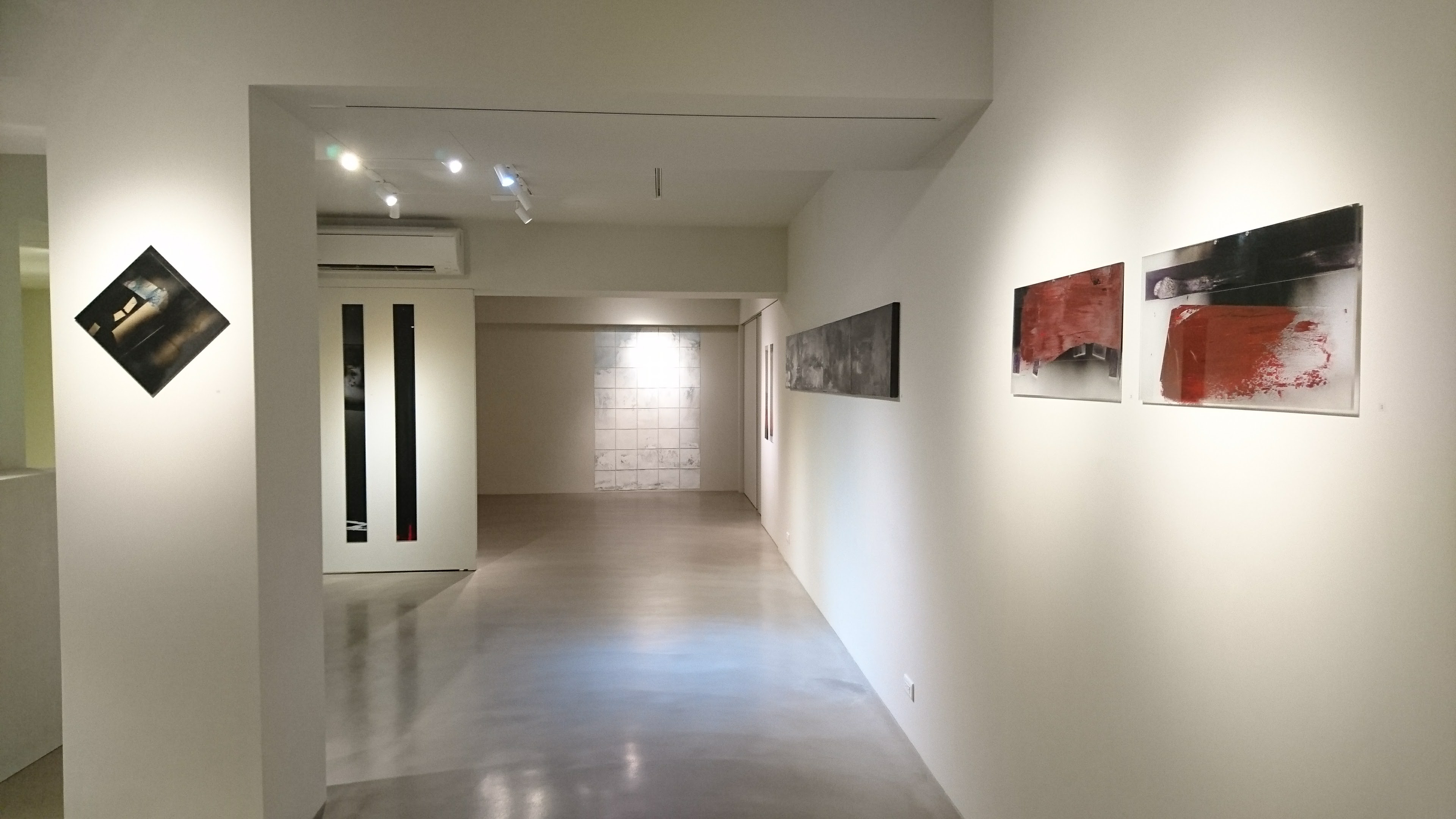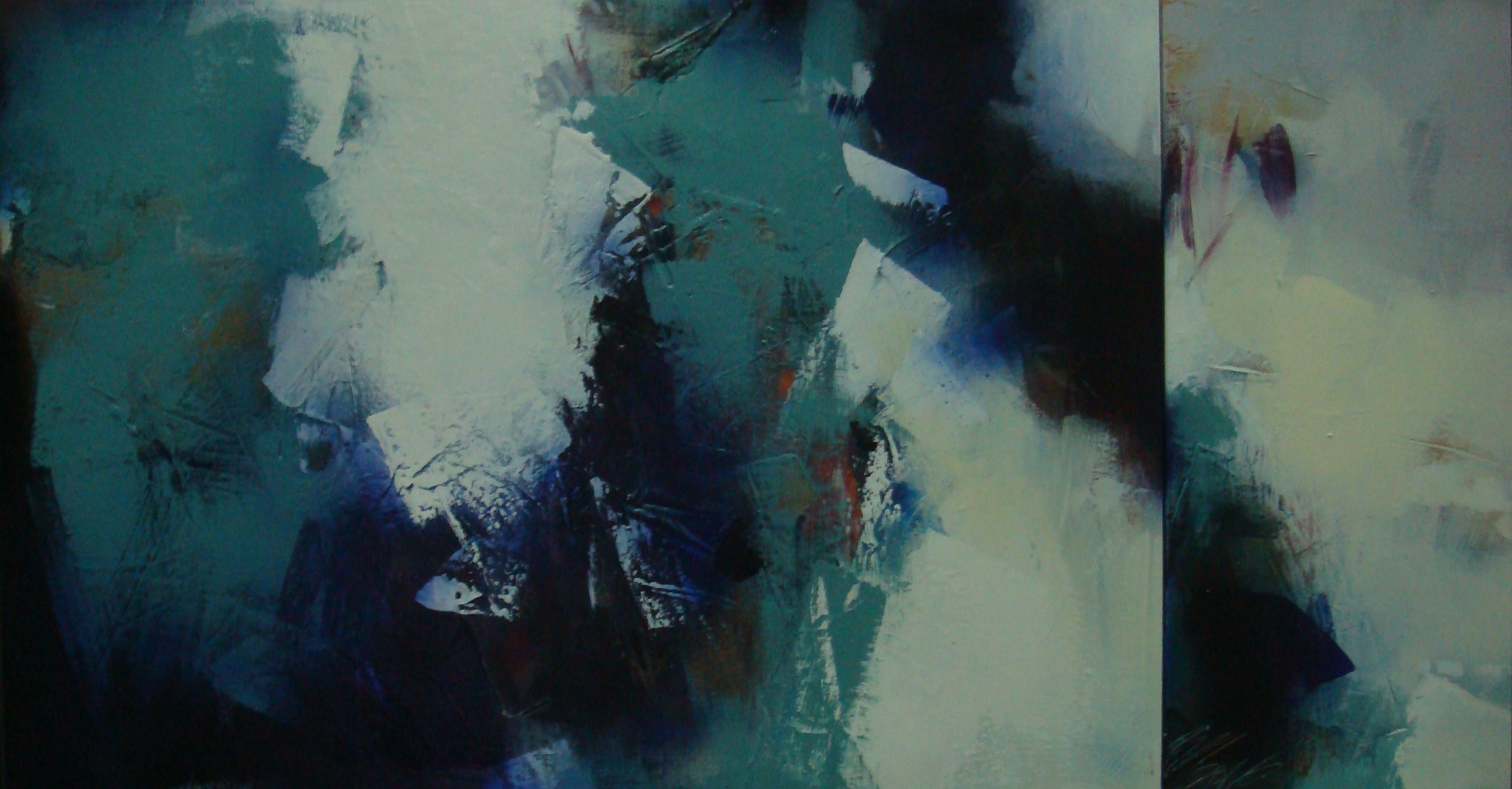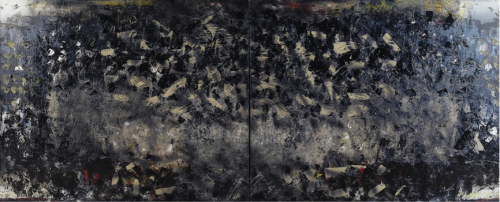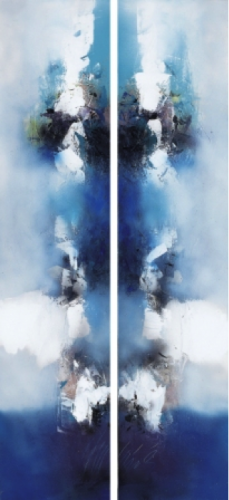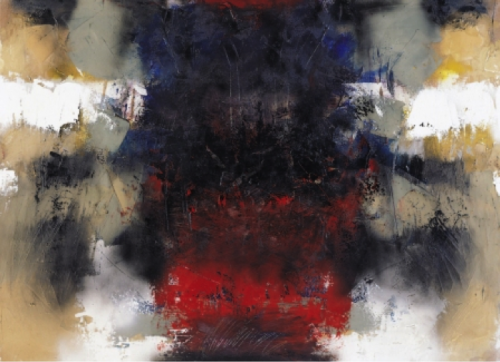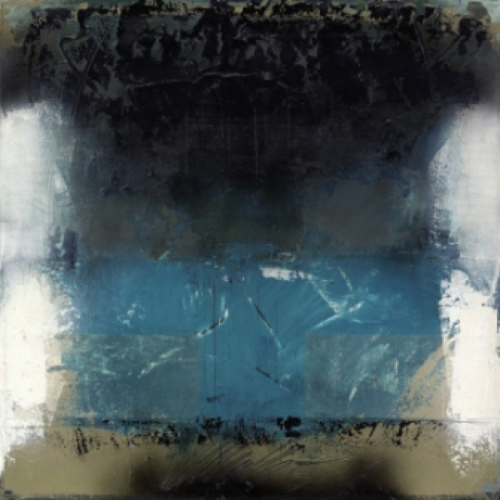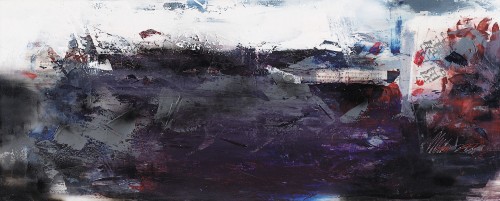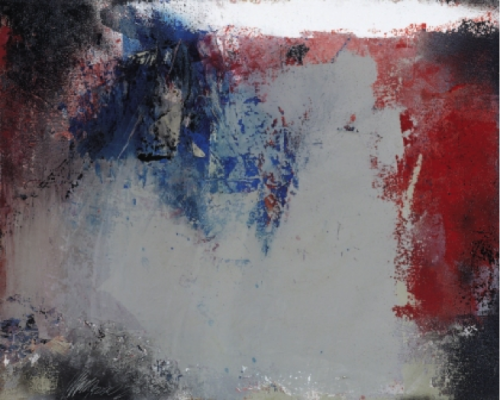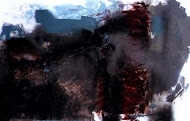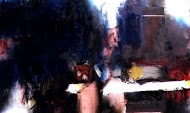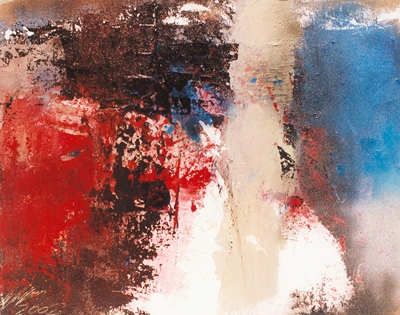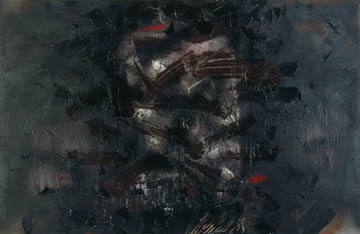這次展覽我刻意選擇了最沒有「繪畫性」的作品並略去了標题及任何可能引發聯想的暗示,為的是讓作品直接「激發」觀者而使作品幽微的内涵得以無礙的進入人心。但願這種纯粹的美感經驗或能開啓觀者某種另類的潛能。
In this exhibition, I present some non-painterly works and to omit its title intentionally. This is to avoid hints that would bring any association to the audience and with such close and intimate communication one might unveil the concealed subtleties abundantly. Hope such aesthetic experience can arouse the alternative potentiality of the audience.
潛質的發微
貝爾(Clive Bell,1881-1964) 於 1914年在英國出版了《ART》,其中第24章提出了「藝術乃有意義之形式」(Art as significant form ) 的論述。在他,藝術品作作爲審美的標的若不能激起「美感」就應被逐出「藝術的自治國度」(1)之外。此前康汀斯基於1912年在德國的《藍騎士》發表了「關於形式問題」 (Über die Formfrage) 強調了藝術形式的精神內涵(Soul of the form) 。他們一個在理論上提示了欣賞的原則;一個着眼於創作的根源,其英雄所見都同時指向「精神性」的核心範疇。這種「巧合」或許正是廿世紀初葉歐洲的政經與文化氛圍使然。更有趣的是藝術史上兩位抽象畫的先驅蒙德里安與康汀斯基都曾受感於布拉瓦茨基夫人(Helena Blavatsky)所倡導的通神論(Theosophy)。通神論者認爲藝術家們過去所追求的是「表面的真實」而因此遮蔽了「内在的真實」,所以藝術家應當揚棄對短暫現象的描摹而追求事物的純粹本質。這種帶著濃濃宗教色彩的神祕學説在當時已擴散甚廣以致許多人都深信人可以從有形的物質狀態「神化」到純粹的精神狀態。因此康汀斯基在文章的開場就直言:「到了命定的時刻,這種必然性已臻成熟」。對於他的理論建構,康氏是用了全然的直覺跳躍而非縝密的邏輯思考。他認爲:創造性的精神不僅是被遮蔽在物質的背後也同時隱藏在物質之中。他所揭櫫的精神內涵正是貝爾所強調「有意義的形式」之所本。本此,以物質形式呈現的藝術品只是精神內涵的載體,它若不能直指核心就變得毫無意義。然而內在精神如何顯發於物質形式之上呢?物質形式主動的「顯發」(Narrate) 其精神内涵早爲實證主義者所否定,而精神内涵在物質形式中被動的「激發」(Provoke) 了觀者的內在感情則是貝爾常常點明的。本此,揭開作品藝術美的按鈕應是存在於各個欣賞者的心理。
由於康汀斯基與貝爾都同時切斷了作品與自然的臍帶。欣賞這類沒有可供辨認形象的純粹作品不論是「抽象」(Abstraction) (2) 或是「非形象」(N0n-objective) (3) 都是極端個人化而沒有客觀標準的。嚴格的説,它甚至連可通約的最大值(commensurability)都不可得。因此去做説明或企圖去了解都成了難題,就連康氏也坦承:「這些穩藏的精神能了解的人不多」。了解是立基於作者與觀者的共鳴(Resonance) ,但共鳴的基礎之難得者至矣。所幸到了H.G. Gadamer 的手中將詮釋學定位爲一種有關理解的本體論。他認爲藝術品的意義不僅僅是創作者的原意,更重要的是觀賞者對該作品的理解意義。這種意義經由以語言爲媒介的傳遞與擴充形成了一個無限的過程。美國學者 E.D.Hirsch Jr. 在其1967年發表的「解釋的有效性」 (Validity in Interpretation )中把作者以系列符號的確定表達定義為 Meaning,而把作品與某人、某系統、某情境之間的變化關係定義為 Significance。至此,精神內涵的拓展隨著時間的推移有了倍數的增長。然而這種自由也可能被擴張到無邊無際。從極僵化的限制到絶對的自由彷彿一艘出港的小船航向茫茫的大海,沒有羅盤的定位則難免有觸礁的可能。在藝術品的欣賞上,貝爾也否定了經驗與知識的必要性。他說:"我們不需要把生活經驗帶進作品的欣賞中也不需要相關於作品理念及事務方面的知識,不需要熟悉作品要表達的情感。藝術把我們從人的行動世界帶入昇華的美境。就在這一刻,我們被隔離在人慾,期望之外,同時我們的記憶也被捆鎖。此時我們被提升到生命不息的川流之上」。我並不排除這種天才型的靈敏心靈但對普羅大眾而言那畢境是些特例。對我而言,這只是欣賞初階的一個純主觀感受階段,如同禪師所指出的「見山是山」(4)。而美術史所建構的理論以及個別佳作所匯總而成的品味典範也是揭發作品內涵所需修習的。知識有可能導致一時的「見山不是山」,但終究這是進入「見山又是山」的必經之途。
這次展覽我刻意選擇了最沒有「繪畫性」的作品並略去了標题及任何可能引發聯想的暗示,為的是讓作品直接「激發」觀者而使作品幽微的内涵得以無礙的進入人心。但願這種纯粹的美感經驗或能開啓觀者某種另類的潛能。
註:
(1) Clive Bell 認爲藝術無關生活狀態與社群關係。它是一個自治的國度(Autonomy) 排除了有暗示或資訊性的「描述繪畫」、心理或歷史性的「肖像畫」、地誌學作品、說明或故事性的圖式、以及各種圖解、圖案或插圖。舉凡不能引發審美的感動的都在排除之列。
(2) 第一種抽象方法是從自然形象抽離或重組的「合理再構造」。
(3) 第二種抽象方法是以繪畫的基本元素作「主觀再創造」
(4)《指月錄》卷二十八。
見山是山…見山不是山…見山仍是山
(林勤霖)
Unveiling the concealed subtlety
In 1914 Clive Bell published 《Art》in England. He delivered the idea of “Art as significant form” in chapter 24. He excluded those works that produce no aesthetic emotion from the autonomy of art. (1) Before this event, W. Kandinsky issued"Über die Formfrage"in 《Der Blaue Reiter, 1912》in Germany. He granted that the “soul of form” is the pivot of an artwork. Bell pointed out the principle of appreciation theoretically while Kandinsky indicated the very root of creation. Their great minds both pinpointed to the core of spirituality. Maybe the politico-economical and cultural atmosphere of the 20-century in Europe fashioned this coincidence. By further study I found with interest that the forerunners of abstraction—W. Kandinsky and P. Mondrian once indulged in"Theosophy"founded by Helena Blavatsky . Theosophists deemed the“external form"once artists pursued as a black veil to conceal the"inner truth."So, artists should quit following the transient exterior surface and entering the spiritual realm to search the essence of matter . Such mysteriously religious impact strode toward the public finally. Many believed that the sheer spiritual state can be achieved through ”transcendental laws."Mirroring this modishness, Kandinsky declared in the beginning of the said essay:"At the appointed time, necessities become ripe."He reached this conclusion by a kind of intuitive leap rather than by meticulously logical thought. He emphasized that the Creative Spirit is not only hidden behind matter, but also concealed within matter. The spirituality which he highlighted is the very source of the ”Significant form"of Bell. Now, we can see the artworks in material form are nothing but the vehicle of the soul. So, the artworks are worthless if it does not pivot on the spirituality. But how can the material form carry the spirituality is another problem. The narration of the material form has already denied by the Empiricist and Bell pointed out that the aesthetic emotion of the audience is provoked by the spirituality dwells in works of art. So, the button to unveil the artistic beauty is inside the heart of the audience.
Because Kandinsky and Bell have cut off the connection between artworks and Nature, so artworks that not symbolize the visible world are extremely personalized. As a result, objective criteria and even commensurability are hard to set both in Abstract (2) or Non-objective (3) works. So, it is difficult to understand or to explain for such. Kandinsky admitted that the veiling of the Spirit in matter is often so dense that there are generally few people who can see through it. In my viewpoint, comprehension is based on the resonance between sender and receiver. To reach a perfect resemblance is almost impossible in a way. Thanks to H. G. Gadamer for his resolution. According to his theory, the meaning of an artwork can be extended as the viewer legitimately interprets the work. So, the derived meaning can be infinite through such chain process of reflecting interpretations. The American theorist E.D. Hirsch jr. defined Gadamer’s idea of extended meaning as “significance” in his treatise <Validity in Interpretation, 1967>. With the expansion of “meaning,” the cultural growth which has been accelerated by mind-storming is forming a huge pyramid of knowledge. But such a once-bound freedom would possibly expand to an extent that it is like a vast ocean while someone trying to row across it. How dangerous it is if there is no compass available. On the issue of art appreciation, Bell denied the necessity of having experience and knowledge. He stressed:” To appreciate a work of art we need bring with us nothing from life, no knowledge of its ideas and affairs, no familiarity with its emotions. Art transports us from the world of man’s activity to a world of aesthetic exaltation. For a moment we are shut off from human interests; our anticipations and memories are arrested; we are lifted above the stream of life.” I would admit that having such sensitive genius is possible, but such subtle comprehension is not for the public. To me, this is only the first step of the journey of art appreciation as the Zen master mentioned: “A mountain seen is a mountain being.”(見山是山)(4) Meantime, the well-constructed theories and collection of master pieces deserve close scrutiny. Although it might make the second stage as “a mountain observed is no mountain being,” (見山不是山) but this is an access to reach the state of “a mountain perceived remains a mountain being.”(見山仍是山)
In this exhibition, I present some non-painterly works and to omit its title intentionally. This is to avoid hints that would bring any association to the audience and with such close and intimate communication one might unveil the concealed subtleties abundantly. Hope such aesthetic experience can arouse the alternative potentiality of the audience. .
Footnotes:
*(1)Bell insisted that Art is independent of life and social relations. He believed descriptive paintings, portraits of psychological and historical value, topographical works, pictures that tell stories and suggest situations, and illustrations of all sorts are not genuine art.
*(2) “Abstraction” is to abstract the favored part(s) or to eliminate the irrelevant details to shape a “reasonable re-formation.”
*(3) ” Non-objective” or “Non-figurative” is to construct painting elements independently to develop a “subjective re-creation.”
*(4) A Zen saying: A mountain seen is a mountain being, a mountain observed is no mountain being, a mountain perceived remains a mountain being
By Lin, Chin-Lin






